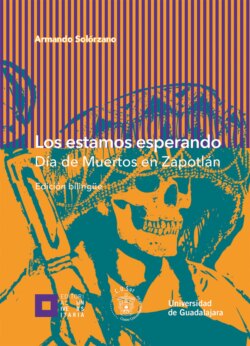Читать книгу Los estamos esperando - Armando Solórzano - Страница 8
Acknowledgments
ОглавлениеThis book belongs to all, especially to those who have passed away. On a visit to my parents’ grave in Zapotlán, Jalisco, I was fortunate to meet María Guadalupe Velazco Cuevas, director of the Miguel Hidalgo cemetery. On the exemplary care with which she maintains the tombs’ impeccable condition, Lupita added: “I take care of all the dead ones alike. I feel that all the dead are my children”. Since then, she has been a source of information for this volume.
I owe much to Martin Benito Montiel, who has a great passion for the tradition of the Día de Muertos in Zapotlán. His objective is to find the differences between the celebration of the Día de Muertos in Zapotlán and the celebrations of the dead in the rest of the world. He is not a trinitarian. He understands life in terms of fours: four cardinal points, four seasons, four heavens, four spiritual drinks, and four types of corn. In the same way, I also want to acknowledge Mr. Enrique Hernandez, who literally knows everything about the old cemetery in Zapotlan. His interviews granted me new insights into the complexities of dealing with the dead and the diversity of philosophies that attempt to explain the mystery of dying.
Latino students at the University of Utah’s Photography Department helped me improve my photography. Kim Mazza and Julio Ramírez shared ideas, cameras, lenses, and Photoshop techniques. Since childhood, I have always admired the local photographers of Zapotlán, especially don Julio Gómez García y don Benjamín Cárdenas, who were very meticulous about their work but never wanted to share their professional secrets with me. In the last fifteen years, I have had several conversations with José Luis Salvador Martínez, from whom I learned that even with a modest camera, one is able to capture the emotions and feelings of the people. I send my gratitude to Professor José de Jesús Guzmán for granting me access to cultural-religious events. Without him I would not have encountered the people who you now see in the photos of this book. All photographic and printing equipment I used was financed in part by the Department of Family and Consumer Studies and by the Ethnic Studies Division at the University of Utah. They granted me a sabbatical to finish writing and designing this work, and I am grateful for their support.
Professor Kevin R. Rathunde at the University of Utah provided me with literature to support the methodological underpinnings of this book. It is not just a matter of taking a picture. For a picture to become art or an educational tool it is necessary for it to have a purpose, an intention to see the world beyond its appearance, and to avoid unnecessary and repetitive recreation of reality. I owe many thanks to Professor Rafael Vázquez Gutiérrez at the University of Guadalajara, who reviewed portions of the manuscript and made valuable suggestions. Tom Gelsinon developed the fluidity and clarity of the text’s English prose, and I’m grateful for the time and energy he invested in editing the manuscript. In the same way, Rogelio Ballesteros, at Instituto Amigos del Sol in Oaxaca, made sure that the spanish text is impeccable; I value our professional relationship, and appreciate even more his unconditional friendship. I will be eternally grateful to the University of Guadalajara Press for its efforts to publish this work and the energy invested in its artistic design..
My apologies to the people I interrupted while they were honoring their deceased at the cemetery. The photographs in this book are my small offering of compensation and an opportunity to resurrect the ones that you love. Thank you also to the people who didn’t allow me to take pictures at the various sites and ceremonies where the Día de Muertos is celebrated. Your loved ones live in our collective memory. The photo does not matter.
